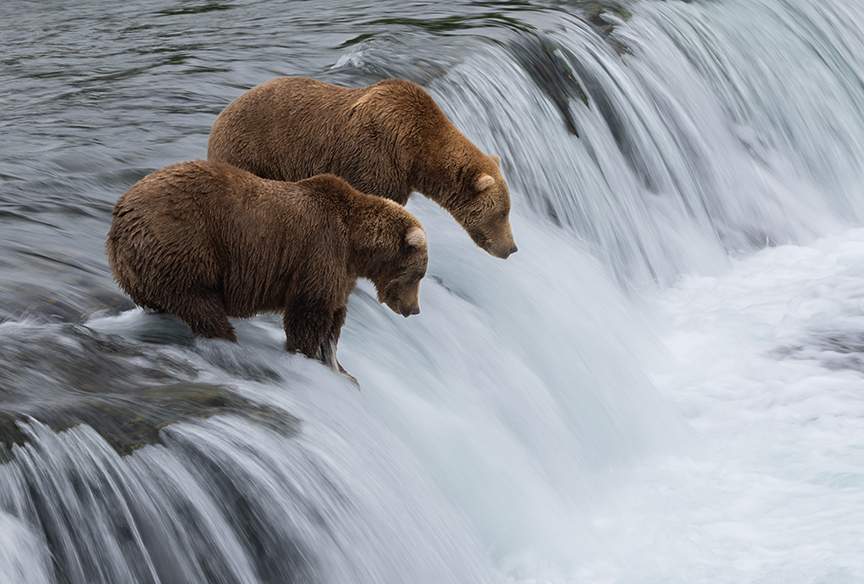Watching animals go through their daily routines, even when there’s not a lot happening, is a good way to relax — hence the popularity of live wildlife cams. These cameras are often seasonal, as migrations or weather bring different species into the spotlight.
Below, a list of the best feeds currently on explore.org, a repository of nature films and live streams. From bears snacking on salmon to wildebeest crossing the Okavango Delta, here are the best live streams for October.
5. Alligators and spoonbills, St. Augustine, Florida
When the sun is up, alligators flop like logs by the water in St. Augustine Alligator Farm Zoological Park. They don’t do much, but that’s okay. They’re alligators.
At night, roseate spoonbills and herons dominate the scene. Spoonbills, once hunted nearly to extinction for their distinctive pink feathers, now thrive across the southeastern United States. A few of them are guaranteed to be curled up in front of the camera.
The nighttime soundscape is gentle but comforting, with the occasional birdcall. During the day, though, the conversation of human visitors makes muting a better option.
4. Polar Bears, Churchill, Manitoba
This live stream rewards patience. At night, a stationary camera focuses on the subarctic shrubbery outside the Tundra Buggy Lodge, a hotel in Canada’s northern Manitoba, which hosts polar bear spotting tours. The only sound is the rush of the wind. During the day, the camera pans over the scrappy tundra.
But the thrill of spotting a polar bear sloping across the screen is worth it. The Churchill Wildlife Management Area heavily restricts visitors to protect this stretch of coast for polar bears and other keystone species.
Polar bears face existential threats in areas like this one, as climate change melts the sea ice on which they do most of their hunting. This is the best time of year to view polar bears at Churchill, because they’re all hanging out, waiting for nearby Hudson Bay to freeze so they can start hunting and eating again.
3. Underwater Reef Cams, Utopia Village, Honduras
At night, the screen is pitch black, but the burble of water justifies the WiFi usage. When sunlight turns the water a striking turquoise, fish dart in and out of the corals. Occasionally, something larger looms up out of the distance and passes in front of the screen like a leviathan.
Utopia Village used to be a dive resort, but after the COVID-19 shutdown, its owners decided not to reopen. Now, they operate their location as a marine conservation center.
2. Boteti River zebra migration, Botswana
Of all the live streams currently on explore.org, this one stands out for its soundscape. Birds gibber and yowl. Wild dogs chirp. Other creatures of indeterminate species make noises that defy categorization. Even without the stunning video, this live stream is worth putting on in the background.
During much of the day, nothing moves across this sandy river in the Okavango Delta. But at night, the landscape comes alive. Zebras meander through the scenery, stopping to drink on their 500km migration to the Makgadikgadi salt pans. Wildebeest travel with them and frequent the river by themselves as well. Occasionally, a herd of elephants comes to splash in the water.
On tonight’s stream, in the early hours of the Botswanan morning, a herd of wildebeest passed in front of the camera. When they had crossed the river, a sudden flurry of wild dog barks broke out. The wildebeest froze, scanning the shore near the camera for the threat. But no wild dogs appeared. The herd relaxed and moved on into the morning light.
1. Brooks Falls Brown Bears, Katmai, Alaska
There’s a reason these bears consistently top the most-viewed list. With 40 bears often onscreen at any one time, there’s no shortage of entertainment. The white noise of the water offers a pleasing background to emails, Excel sheets, or coding. And anytime a bear catches a salmon, it feels like a personal victory.
This live stream overlooks the rapids of a two-kilometer stretch of the Brooks River, right along the fall sockeye salmon run. The brown bears here eat up to 40 salmon a day in preparation for winter hibernation. As fall progresses, they will continue to fatten.
Cubs splash in the less oversubscribed stretches of the river, learning to catch salmon for the first time. Victorious old bears feast, turning wide brown eyes to the camera. Some bears, tired of fishing, sit down in the river and just enjoy the waves lapping their fur. There is plenty of salmon for everyone.

